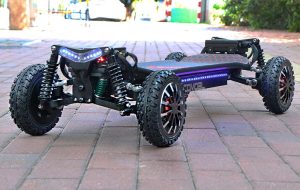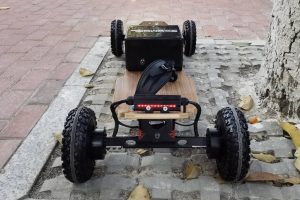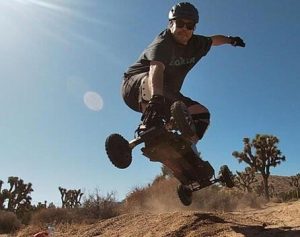Electric skateboards and mountainboards are fun ways to get outside and ride, but they offer different experiences. An electric skateboard is designed for riding on streets, sidewalks, and smooth terrain, while a mountainboard is built for navigating rugged, unpaved trails. Before investing in either, it is important to understand the key differences in design, capability, and riding style to determine which will best suit your needs and riding preferences.

Overview of Electric Skateboards and Mountainboards
Electric skateboards and mountainboards have different origins and purposes. Electric skateboards evolved from traditional skateboards and street boards. They feature electric motors mounted underneath to propel the rider while maintaining a low profile and lightweight, compact design ideal for urban riding. Electric skateboards are ideal for short-distance cruising on pavement, sidewalks, bike lanes, and smooth, even terrain.
In contrast, mountain boards originated as off-road electric vehicles for navigating unpaved trails, dirt tracks, and rugged terrain. They are built with wider, knobby tires and larger, more powerful motors than electric skateboards to handle rougher conditions. Mountainboards also typically have higher ground clearance, shock absorbers, and heavier-duty components that withstand impacts and obstacles. Mountainboards are designed specifically for off-road exploring on natural trails, hiking paths, dirt roads, and mountain biking trails.
Although based on different concepts, electric skateboards and mountainboards provide motorized riding thrills and adventures. The key is choosing the option engineered and intended for your preferred terrain and riding style. With a proper understanding of what each can do, you can navigate confidently wherever the ride takes you.
Benefits of Electric Skateboards
Electric skateboards offer several advantages over mountainboards for riding on paved surfaces. Electric skateboards are designed for street riding, so they handle traffic, turns, and obstacles smoothly and precisely. They also typically have smaller, softer wheels better suited to pavements rather than rough terrain.
Electric skateboards are also more lightweight, compact, and portable than mountainboards. They are easy to disassemble and store in a trunk or backpack when not in use. This makes them highly convenient for commuting short distances or running occasional errands. In contrast, mountain boards are heavier, bulkier, and less suitable for short trips or transportation.
Another key benefit of electric skateboards is cost. Because they are designed primarily for recreational riding on roads, electric skateboards often have lower price points than dedicated off-road vehicles like mountainboards. They also tend to require smaller, less powerful motors that are more affordable. So, electric skateboards can provide motorized riding at a lower upfront cost and maintenance expense.
If maximizing efficiency, minimizing fuss, and keeping costs in check matter most, an electric skateboard is probably your best choice over a mountainboard. However, if extreme off-road adventure is what you seek, a mountainboard will enable experiences that simply can’t be matched on a road-focused electric skateboard. The benefits of each depend on how and where you want to ride.

Benefits of Mountainboards
Mountainboards offer significant advantages for off-road exploration and adventure riding. To start, mountain boards are built from heavier-duty, more durable components that can withstand the impacts and stresses of rough terrain. They have oversized pneumatic tires with deep treads explicitly designed for grip on dirt, gravel, grass, and rocky trails. These tires provide much more traction than the smaller wheels on electric skateboards.
As a result, mountain boards can navigate rugged, unpaved trails that would quickly damage an electric skateboard. They can handle hiking paths, fire roads, dirt, and mountain biking trails. Mountainboards typically have larger battery packs and more powerful motors than electric skateboards for conquering steeper grades, looser surfaces, and heavier loads.
Another key benefit of mountain boards is that they are designed to withstand being thrown or scraped against rocks and obstacles. They provide more frame clearance, impact protection, and rugged construction than a standard electric skateboard. So, mountainboard riders can enjoy a more carefree riding experience without worrying as much about dents, dings, or other damage to their vehicle.
If maximizing your capability for adventure and exploration is most important to you, a mountainboard will likely far surpass the capabilities of an electric skateboard. However, mountainboards are also more expensive, bulkier to transport and maintain, and less suitable for everyday commuting. For some riders, the convenience trade-off is worth the extreme capability and durability benefits. For others, an electric skateboard strikes a perfect balance. It depends entirely on how and where you want to ride.
In summary, both electric skateboards and mountainboards offer unique advantages for different types of riding experiences. The key is choosing the option that fits your priorities, skills, and riding preferences. With an understanding of what each can do, you will be out enjoying motorized thrills on the trails and roads with a smile.

Considerations to Take When Choosing an Electric Skateboard or Mountainboard
When deciding between an electric skateboard and a mountainboard, there are several important factors regarding your specific needs, skills, and riding preferences. Some key things to keep in mind include the following:
- Intended use: Are you seeking short-distance commuting, casual riding, or long-distance off-road adventure? Electric skateboards excel at the former, while mountainboards are better suited.
- Terrain: Do you plan to ride primarily on pavement, dirt trails, or rugged terrain with obstacles like rocks and roots? Choose according to the conditions you will face.
- Technical ability: Mountainboarding requires more skill to handle rough terrain and obstacles. Consider your level of experience and comfort with technical riding.
- Speed and power: Mountainboards typically offer larger battery packs and more powerful motors for faster riding and higher torque, while electric skateboards have less powerful components for urban riding. Assess how speed-oriented you are.
- Portability: Electric skateboards are usually more compact and lightweight, easier to disassemble and store or transport. If storage space is limited, an electric skateboard may have the advantage.
- Budget: Although prices vary, electric skateboards often cost less than mountainboards, especially higher-end models. Set a budget and choose according to your needs at that price point.
- Additional features: Consider what extra features, like shock absorbers, cargo racks, headlights, etc., will enhance your riding enjoyment and choose the vehicle that best supports those features.
- Local laws: Some areas restrict motorized vehicles like electric skateboards and mountainboards. Make sure any option you consider is permitted legally where you will be riding.
By thoughtfully evaluating your priorities, skills, and needs, you can determine whether an electric skateboard, mountainboard, or even both could make an ideal ride for you. Make an informed choice, and you will enjoy safe, enjoyable riding adventures for years.
Read More
- Some Real Feelings Of My First Riding On Mini 2
- The Differences Between Electric Scooter And Electric Balance Car
- Ecomobl Et Review True At Electric Skateboard Hq
- Ecomobl Really Paid Great Attention To Their Customer Service
- The Differences Between Direct Drive Motor And Belt Motor




